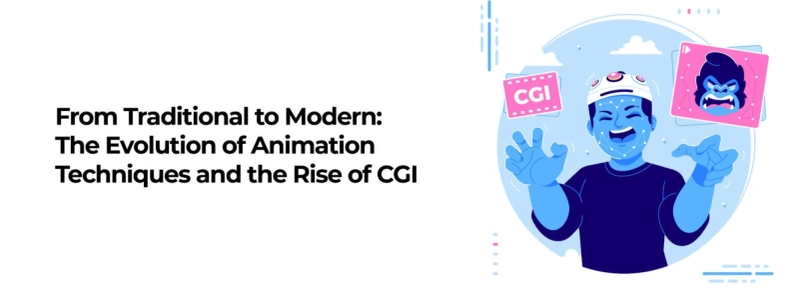The entertainment business is soaring to new heights because of the advent of CGI. Thanks to this innovation, filmmakers may create surreal worlds that make viewers doubt reality. CGI animation has both benefits and drawbacks, much like any other kind of technology.
In order to offer a thorough overview of this evolving discipline, we shall explore the many advantages and disadvantages of computer-generated animation in this blog.
What is CGI Animation?
Computer-generated imagery animation, or CGI animation, is the creation of animated images entirely in a digital environment. Computer algorithms and specialized software are used to create realistic or stylized animated characters, settings, and effects. By digitally creating and manipulating virtual objects and scenarios, CGI animation enables filmmakers, animators, animated explainer video companies and artists to realize their creative ambitions.
Advantages of CGI Animation
Realism and Visual Spectacle:
The capacity to produce photorealistic images is a major strength of computer-generated animation. Visually appealing locations, rich textures, and realistic figures are all made feasible by CGI technology that would have been difficult or impossible to accomplish using conventional animation methods. Films benefit greatly from this level of realism because it draws viewers into worlds that seem alive and plausible.
Creative Freedom:
The possibilities for artistic expression with CGI animation are almost limitless. They may fulfill their goal without being hampered by the constraints of reality. They have the ability to make anything imaginable, from exotic creatures to gorgeous landscapes to action sequences that defy the laws of physics.
Cost and Time Efficiency:
While the initial setup costs of CGI animation can be high, it often proves to be more cost and time-efficient in the long run. Once the digital assets and environments are created, they can be easily modified and reused, reducing the need for expensive reshoots or physical set construction. Additionally, CGI animation eliminates the constraints of live-action filmmaking, such as unpredictable weather conditions or expensive location shoots.
Integration with Live-action:
CGI animation seamlessly integrates with live-action footage, enhancing storytelling possibilities. It allows filmmakers to blend real actors with computer-generated elements, creating a cohesive and visually stunning experience. This integration enables the depiction of fantastical creatures, larger-than-life battles, and awe-inspiring visual effects that enhance the overall cinematic experience.
Disadvantages of CGI Animation
High Production Costs
One of the primary disadvantages of CGI animation is the high production costs associated with it. The creation of complex CGI assets, such as detailed characters or intricate environments, requires a significant investment in skilled artists, powerful hardware, and specialized software. The cost of rendering and animating these assets can quickly escalate, making CGI animation prohibitively expensive for smaller production budgets.
Technical Challenges and Learning Curve
CGI animation involves complex technical processes that require specialized skills and expertise. Artists and animators need to stay updated with the latest software and techniques, which can be time-consuming and challenging. Additionally, the learning curve for CGI animation is steep, and achieving photorealism or believable character animation often demands years of experience and practice.
Over-reliance on CGI
In some instances, CGI animation can lead to an over-reliance on visual effects, overshadowing other aspects of storytelling. When used excessively, CGI can become a distraction, detracting from the emotional impact and authenticity of a film. This overuse of CGI can undermine the practicality of on-set filming and stunt work, which may result in a loss of realism and audience engagement.
Uncanny Valley and Realism Limitations
Despite the significant advancements in CGI technology, achieving absolute realism remains a challenge. The "uncanny valley" phenomenon occurs when computer-generated characters or animations appear almost human-like but lack the subtleties and nuances that make them truly convincing. Striking a balance between realistic and stylized animation is crucial to avoid alienating audiences or making characters feel lifeless.
Ethical Considerations in Digital Manipulation
CGI animation allows for extensive digital manipulation, which raises ethical questions regarding authenticity and misrepresentation. Manipulating or altering digital characters, environments, or even actors' appearances can blur the line between reality and fiction. This can have implications in various contexts, such as creating realistic simulations of deceased actors or distorting historical events through fictionalized portrayals. Responsible and ethical use of CGI animation requires careful consideration and transparency to ensure that audiences are not misled or manipulated.
Dependence on Technology and Updates
CGI animation heavily relies on technology, including hardware, software, and rendering capabilities. This dependence introduces challenges related to the longevity and compatibility of digital assets. As technology advances rapidly, older CGI animations may become outdated or inaccessible due to changes in file formats or software compatibility. Filmmakers and studios must consider the long-term sustainability and accessibility of their CGI animations to ensure they remain relevant in the future.
The Bottom Line
CGI animation has undeniably transformed the world of filmmaking and animation, offering tremendous creative possibilities and captivating visual experiences. While it presents several advantages such as realism, flexibility, and cost-efficiency, it also comes with drawbacks such as high production costs, technical challenges, and potential over-reliance on visual effects. By understanding these advantages and disadvantages, filmmakers can make informed decisions on how to best utilize CGI animation to enhance storytelling and captivate audiences in an ever-evolving entertainment landscape.


